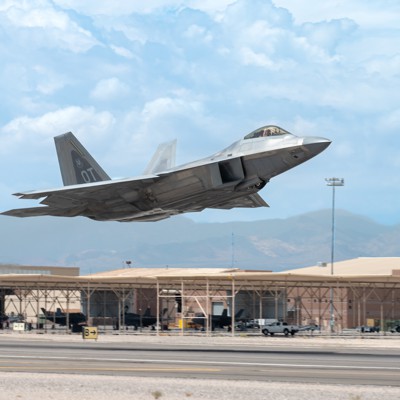Updated: 9:58 p.m. ET.
High above a Nevada test range, an F-22 pilot took control of a combat drone last month, a first for the Air Force’s robot wingman effort.
The pilot used a tablet for “command and control” of the MQ‑20 Avenger combat drone during an Oct. 21 flight at the Air Force’s Nevada Test and Training Range, according to a Monday press release by MQ-20 maker General Atomics, which worked on the demonstration with F-22 builder Lockheed Martin and defense company L3Harris.
General Atomics said the exhibit is the latest in a series of demonstrations backed by its own internal research and development funding to show “the art of the possible” in manned-unmanned teaming. L3Harris used its datalinks and software radios with Lockheed Martin’s open radio architectures to showcase the “non-proprietary, U.S. government-owned communications capabilities,” the news release said.
C. Mark Brinkley, a General Atomics spokesperson, said the demo is believed to be the first of its kind with an F-22. The announcement, which coincides with the Dubai Airshow in the United Arab Emirates this week, comes as General Atomics vies to win the Air Force’s ongoing collaborative combat aircraft competition; a first-increment production design contract is to be awarded in 2026.
“General Atomics is in a pretty unique situation here, given that we already have operational uncrewed jets to use for experimentation,” Brinkley said. “The MQ-20 Avenger, tricked out with mature mission autonomy software, is a perfect CCA surrogate and allows us to move fast and move first.”
After General Atomics’ announcement, Lockheed Martin’s secretive Skunk Works research arm said it had “led and orchestrated” the demonstration.
“This effort represents Skunk Works bringing its diverse and unique expertise to the table to lead the way demonstrating the future of air combat, where single-seat aircraft command and control drones with simple and intuitive interfaces in the cockpit,” OJ Sanchez, Skunk Works’ vice president and general manager, said in an emailed statement.
Last month, the service’s ambitious 10-year fighter jet plan highlighted the service’s push to acquire CCAs to fly with F-22s. The 24-page plan, which was obtained by Defense One, called drone wingmen the “key to controlling future highly contested environments.” F-22 modernization was listed as a top priority, in part, because of its integration with CCAs.
“F-22 remains the threshold platform for CCA integration,” the report reads, adding that the drones will later help next-generation F-47 fighter jets “meet highly contested mission demands.” Production on the F-47 is underway; first flight is expected in 2028.
General Atomics is competing against defense company Anduril for the CCA work. Both companies flew prototypes in recent months, less than two years after launching their development efforts. General Atomics photos released earlier this month revealed the company flew a second CCA this month, just days after Anduril announced its first flight.
Brinkley said General Atomics was eager to begin testing the Air Force’s future concept.
“We don’t want to wait for the CCA fleet to be fielded to begin leaning in on F-22 teaming,” Brinkley said. “We already know the F-22 will play a critical role in crewed-uncrewed teaming operations, and General Atomics is in a unique position to get started now.”
Read the full article here








Leave a Reply